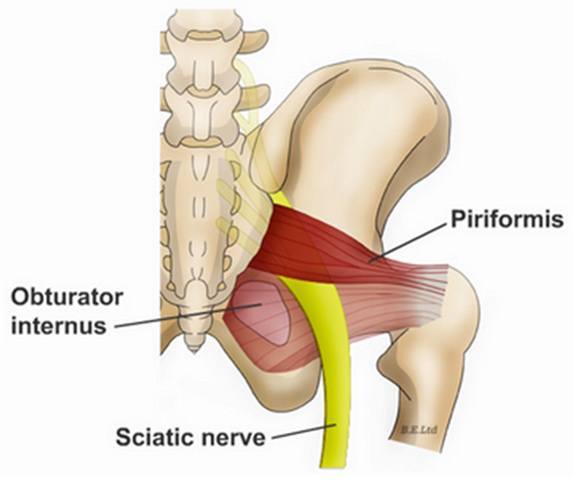Piriformis Syndrome

Piriformis syndrome is an uncommon muscular condition caused by compression of the sciatic nerve by the piriformis muscle. The sciatic nerve is a thick and long nerve that passes below, through, or above the piriformis muscle and goes down the back of the leg and finally ends in the feet as it branches into smaller nerves.
Symptoms
Piriformis syndrome can cause posterior hip pain, deep buttock pain, and shooting pain with numbness and tingling down the back of thigh and leg described as “pins and needles”. Pain is worse with activities which exert pressure over the piriformis muscle such as sitting for long hours, running, or climbing stairs.
Diagnosis
The diagnosis of piriformis syndrome includes a detailed medical history and physical examination. The physical examination may involve manipulation of the hip/leg which may trigger characteristic pain in the buttock and leg. Imaging studies such as MRI may be useful in ruling out other causes of sciatic nerve compression such as lumbar spine degenerative disc disease, spondylolisthesis, spinal stenosis, or arthritis of the spine.
Treatment
Piriformis syndrome can be treated with conservative measures including activity modification, physical therapy, non-steroidal anti-inflammatory drugs (NSAIDs), and local ultrasound-guided cortisone injections.
In rare cases that piriformis syndrome is not improved with conservative measures, an endoscopic procedure to release the piriformis muscle may be indicated.
Dr. Gupta to give a lecture series at Georgetown yoga "Healthy Movements Workshop" focused specifically on hip, knee, and shoulder injury prevention and those patients with existing injuries in April and May.
Dr. Gupta is now "board certified" in Orthopedic Surgery.
Dr. Gupta to present Orthopedic Lecture Series with Sentara Northern Virginia Medical Center titled "Don't Let Hip Pain Slow You Down: Understanding Your Options", September 7th, 2016 at Hilton Garden Inn Woodbridge at 6pm.
Dr. Gupta to present third part of his lecture series on "Master Mobility" at Spark Yoga. His next lecture with be on "Mastering Mobility Of Your Knees" on September 18th at The Shops at Pershing, 2201 N Pershing Dr, Arlington, VA 22201










